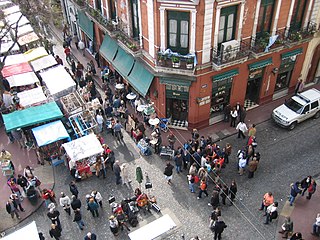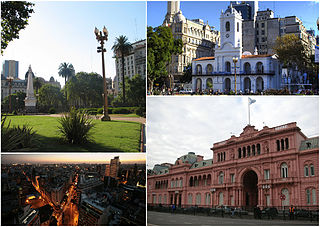
San Telmo is the oldest barrio (neighborhood) of Buenos Aires, Argentina. A well-preserved area of the Argentine metropolis, it hosts some of its oldest buildings. One of the birthplaces of tango, during the mid 20th century it was the Bohemian district with painters ateliers and jazz clubs. Cafes, tango parlors and antique shops line the cobblestone streets, which are often filled with street artists and dancers.

The La Chacarita Cemetery is a cemetery located in the Chacarita neighborhood in Buenos Aires, Argentina. Occupying an area of 95 hectare, it is the largest in the country.

Balvanera is a barrio or neighborhood of Buenos Aires, Argentina.

Palermo is a barrio or neighborhood of Buenos Aires, Argentina. It is located in the north of the city, near the Río de la Plata.

Recoleta is a barrio or neighborhood of Buenos Aires, Argentina, located in the northern part of the city, by the Río de la Plata. The area is perhaps best known to be the home of the distinguished Recoleta Cemetery. It is a traditional upper-class and conservative neighborhood with some of the priciest real estate in the city, known for Paris-style townhouses, lavish former palaces and posh boutiques.

Villa Crespo is a middle class neighborhood in Buenos Aires, Argentina, located in the geographical center of the city. It had a population of 83,646 people in 2001, and thus currently a population density of 23,235 inhabitants/km2. Villa Crespo celebrates its anniversary on June 3.

Almagro is a barrio or neighbourhood of Buenos Aires, Argentina.

Retiro is a barrio or neighborhood in Buenos Aires, Argentina. Located in the northeast end of the city, Retiro is bordered on the south by the Puerto Madero and San Nicolás, and on the west by the Recoleta.

Avenida Corrientes is one of the principal thoroughfares of the Argentine capital of Buenos Aires. Over a central stretch it is popularly known as "The Street that Never Sleeps" widely considered Buenos Aires' answer to Broadway as it concentrates many of the main theatres and cinemas as well as famous pizzerias and cafes, being intimately tied to the tango and the porteño sense of identity. Like the parallel avenues Santa Fe, Córdoba, and San Juan, it takes its name from one of the Provinces of Argentina.

Colegiales is a barrio or district in Buenos Aires, Argentina. It is located between Alvarez Thomas av., Forest av., De los Incas av., Virrey del Pino st., Cabildo av., Jorge Newbery st., Crámer st. and Dorrego av. This neighborhood offers a vast amount of contrast and opportunities.

According to the World Travel & Tourism Council (WTTC) the travel and tourism sector of Argentina was moving towards recovering its pre-covid pandemic contribution to GDP in mid-2023, led by Buenos Aires.

Feria de San Telmo is an antique fair that takes place in the barrio (neighbourhood) of San Telmo, in Buenos Aires, Argentina. It was created in 1970 by architect José María Peña.

Mataderos is a barrio (neighbourhood) in Buenos Aires, Argentina. It is one of the three barrios that make up the Comuna 9, alongside Liniers and Parque Avellaneda. Located in the south-west end of the city, it takes its name from the livestock market and various slaughterhouses located within it.

Plaza San Martín is a park located in the Retiro neighbourhood of Buenos Aires, Argentina. Situated at the northern end of pedestrianized Florida Street, the park is bounded by Libertador Ave. (N), Maipú St. (W), Santa Fe Avenue (S), and Leandro Alem Av. (E). Its coordinates are 34°35′42″S58°22′32″W.

Monserrat or Montserrat is a neighbourhood in the east of the Buenos Aires CBD. The district features some of the most important public buildings in Buenos Aires, including city hall, the city legislature, Casa Rosada, the Colegio Nacional de Buenos Aires and the Libertador Building, among others.

Plaza de la República is a city square in Buenos Aires, capital of Argentina. It is located in the San Nicolás quarter, at the intersection of the city's three main arteries: Ninth of July Avenue, Corrientes Avenue, and Diagonal Norte. It derives its name and associations from a church once sited on the square, San Nicolás de Bari, where the country's national flag was hoisted for the first time.

Avenida Santa Fe is one of the principal thoroughfares in Buenos Aires, Argentina. The artery is essential to the imaginary axis of Barrio Norte in Buenos Aires, comprising the areas influenced by the route of the avenue through Retiro, Recoleta and Palermo neighborhoods, it is considered one of the main shopping and strolling areas of the city, its many boutiques range from elegant to edgy, which has led it to be dubbed the 'Avenue of Fashion'. Upscale Alto Palermo, at Avenida Coronel Díaz, is one of the city's best-known vertical malls. Avenida Santa Fe is also an attraction for its architecture, strongly reminiscent of Paris. Its name pays homage to the eponymous province in Argentina.

The Buenos Aires Museum of Modern Art, known locally as the Museo de Arte Moderno de Buenos Aires (MAMBA), is a modern art museum located in the San Telmo district of Buenos Aires, Argentina.

The Buenos Aires Central Business District is the main commercial centre of Buenos Aires, Argentina, though not an official city ward. While the barrios of Puerto Madero and Retiro house important business complexes and modern high-rise architecture, the area traditionally known as Microcentro is located within San Nicolás and Monserrat, roughly coinciding with the area around the historic center of the Plaza de Mayo. The Microcentro has a wide concentration of offices, service companies and banks, and a large circulation of pedestrians on working days. Another name given to this unofficial barrio is La City, which refers more precisely to an even smaller sector within the Microcentro, where almost all the banking headquarters of the country are concentrated.




















